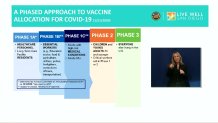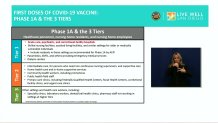What to Know
- San Diego County is expected to get 28,000 doses of the Pfizer vaccine over the next few days -- enough to immunize about 70% of local, critical care health care workers.
- San Diego-based Dr. Natasha Bhuyan said people should expect mild side effects from the Pfizer COVID-19 vaccine, including some degree of pain at the local injection site. The shot is administered in two doses.
- "We also expect people to get things like headaches, muscle aches, chill," Bhuyan told NBC 7.
San Diego County received its first batch of Pfizer’s COVID-19 vaccine Monday -- enough doses to immunize about 70% of local, critical care health care workers, to start.
San Diego County tweeted about the vaccine's arrival Monday just before 9 a.m., also posting this video of boxes filled with the vaccine.
San Diego County was among the many counties in California to receive the vaccine Monday amid the state's surge in infections and hospitalizations. California’s initial batch of the Pfizer vaccine was scheduled to total 325,000 doses.
Where in San Diego Are the First Doses of the COVID-19 Vaccine Going?
What to Know
- Naval Medical Center San Diego and Naval Hospital Camp Pendleton are the first sites to receive the Pfizer COVID-19 vaccine in San Diego County.
- UC San Diego Health is also preparing to receive the vaccine.
- Rady Children's Hospital has been tapped as a storage site for the COVID-19 vaccine due to its highly secure, ultra-low-temperature freezer storage capacity.
San Diego County is expected to get 28,000 doses of the Pfizer vaccine over the next few days, county public health officials said. The vaccinations are expected to be administered Wednesday.
The Department of Defense on Monday announced Naval Medical Center San Diego had received its doses of the vaccine, which were separate from San Diego County's supply. Some of those doses would then be transferred to Naval Hospital Camp Pendleton and both would begin distribution to military medical personnel by Wednesday.
The vaccine was also expected to be delivered to UC San Diego Health.
Dr. Davey Smith, MD, MAS/Head of Infectious Disease at UC San Diego, told NBC 7 he would be one of the first frontline health care workers to be given the vaccine in San Diego.
He was ready.
“I’m super hopeful,” Smith told NBC 7. “It’s like the end of the beginning of all of this mess, right?”
“My arm is ready. I’m ready,” he added.
Smith said vaccinating health care workers is a critical first step to rolling out the vaccine the right way.
“That whole purpose is to protect our health care infrastructure,” Smith said. “We need people who can take care of us, when we get sick, so that’s the reason we’re giving those people the vaccine first.”
Smith said the vaccine will add “another level of security and confidence” in San Diego’s healthcare system and, in his words, “hopefully reinvigorate us.”
With more protection against the virus, the UC San Diego doctor said he hopes it strengthens the healthcare workforce.
Rady Children’s Hospital in San Diego will also receive the vaccine, as the facility is equipped with highly secure, ultra-low-temperature freezer storage capacity.
Rady Children’s was asked earlier this month by the California Department of Public Health to serve as a site to store COVID-19 vaccines until they were approved by the FDA for distribution.
Who Gets the COVID-19 Vaccine First in San Diego?
Last week, county health officials shared a plan on who would get the COVID-19 first in San Diego County.
The plan is organized into three phases.
In the first phase – which has three parts – health care workers will be the first to receive the COVID-19 vaccine, followed by long-term care facility residents and employees.

Essential workers come after that – in the second part of Phase 1 – including those who work in food and agriculture, education, transportation, and as firefighters, police officers and correctional officers.
In the final part of Phase 1, the county will prioritize vaccinating adults with underlying medical conditions and those who are over the age of 65.
Read about the Phase 2 and Phase 3 here.
Smith said UC San Diego Health is working through the logistics of figuring out who will get the first doses of the vaccine.
“We don’t have enough of this vaccine to go around for everybody at the moment,” he said.
So, Smith said it’s important for people to – in the meantime – keep practicing good COVID-19 guidelines like keep proper social distance from others, wearing a mark, and avoiding group gatherings – especially indoors.
“That still seems to be the biggest risk of transmission with this virus,” he explained. “The winter is going to be really dark.”
Scripps Health in San Diego released some information Monday about its initial Tier 1 distribution of the COVID-19 vaccine, saying it was working with local and state governments to receive, distribute and administer the vaccine – with a focus first on health care workers at greatest risk.
“Scripps anticipates receiving a limited supply of vaccines initially which will go to Tier 1 health care workers with regular or prolonged exposure to confirmed COVID-19 patients,” Scripps Health said in the statement released to local media. “These workers include all staff, providers and physicians in the intensive care units, emergency departments and designated COVID-19 units. This includes staff members in roles that are not clinical in nature but may require visits to these high-risk areas.”
Scripps Health said it planned to start those Tier 1 vaccinations for health care workers on Thursday.
“Doses will be administered fairly and equitably, taking into consideration those who are at greater risk as well as initial vaccine availability,” Scripps Health added. “All staff and providers in Tier 1 will be asked whether they want to receive the vaccine and the vaccine will not be mandatory. The process will then move on to those roles covered in the next tier as vaccine is available.”

San Diego-Based Doctor Explains What Patients Can Expect After Getting COVID-19 Vaccine
“It’s been shown that this vaccine is both safe and effective for the majority of people to get,” said Dr. Natasha Bhuyan, a family physician at One Medical.
“A lot of people ask me about the technology. A lot of people say, ‘Gosh, was this vaccine developed too quickly?’ And the reality is, the vaccine was developed in a really appropriate timeline that did assess for safety," Bhuyan said. "That vaccine technology we’ve developed, we’ve been looking at for years. It’s something we’ve studied for more than a decade."
Bhuyan said people who get the vaccine should expect mild side effects.
“I don’t think it’s talked about enough. What I don’t want to happen is people get the vaccine and then they get expected side effects and then they don’t want to get the second dose," she added. "When we look at the side effects of the vaccine, more than 80 percent of people in the vaccine trial had some local pain at the injection site, 47 percent of people had fatigue. We also expect people to get things like headaches, muscle aches, chills."
She said there are also “special groups” who weren’t studied in the vaccine trial, like pregnant women, people who are immunocompromised, and children under the age of 16.
“Because there are all these special populations who likely can’t get the vaccine, at least not initially, it’s more important that the rest of us agree to get the vaccine so we can achieve heard immunity,” said Bhuyan.
According to former FDA Chief Dr. Margaret Hamburg, the Pfizer vaccine will be administered with two shots in the arm and may trigger side effects like fatigue, swelling, some pain, irritation or headache. Some patients who have taken the vaccine reported chills and low-grade fever.



